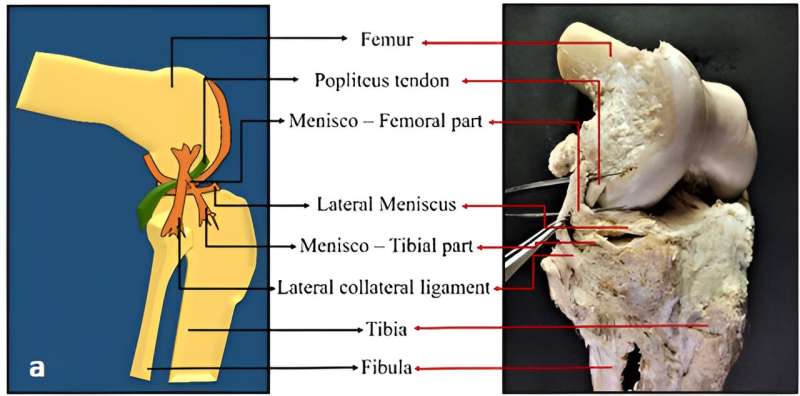August 9, 2023 dialog
This article has been reviewed according to Science X's editorial process and policies. Editors have highlighted the following attributes while ensuring the content's credibility:
fact-checked
peer-reviewed publication
trusted source
written by researcher(s)
proofread
Unraveling the novel morphological features of an elusive knee ligament

Complex and strenuous movements at the knee are modulated by ligamentous structures surrounding the joint. One of these ligaments, the anterolateral ligament (ALL), has continuously puzzled scientists due to its elusive morphological characteristics.
It was first described by Paul Segond in 1879 as a "pearly, resistant, fibrous band" connecting the lateral femoral epicondyle to the lateral condyle of the tibia. However, its identification remained disputed until recently, as it was unknown whether it is a true ligament, capsular thickening or fascia.
In 2013, Claes et al garnered attention from the scientific community for providing a detailed morphological description and validating its ligamentous structure. They described its proximal attachment to the lateral femoral epicondyle and distally on the lateral meniscus and the tibia, midway between Gerdy's tubercle and the fibular head.
This report inspired further evaluation of the ligament. Interestingly, later research published on the ALL reported its varied proximal attachments to the femur. Moreover, the relationship of the ALL with the lateral collateral ligament (LCL), which also arises from the lateral epicondyle, presented a lack of consensus among the research community.
The dominance of a conjugate form of the ALL and LCL
We recently published an original study in the journal Scientific Reports that investigated the ALL morphology in the North and East Indian population. In 97% of the cadaveric specimens where an ALL was present, it originated as an oblique band from the LCL due to the sharing of the proximal fibers (see figure above). Our study strongly indicates that proximal sharing of LCL–ALL fibers is dominant in knee anatomy in the North and East Indian populations. This contrasts with the conventional description of the ALL with a direct proximal attachment to the lateral femoral epicondyle.
Novel morphological variants and cases of a missing ALL
We also observed other novel morphological variations in the presentation of the ALL. These variations include an inverted ALL, where the distal part of the ligament runs upward and attaches to the lateral meniscus or knee joint capsule. Another variation is a tibial limb that appears as a flat fascial band expanding from the LCL. Interestingly, the ALL was absent in approximately 20% of individuals.
Clinical implications
The morphological variations in the ALL may have implications for the anterolateral stability of the knee and should be considered during ligament reconstruction surgeries. The findings of our study strongly indicate that ethnic variations in the ALL anatomy should be considered during surgical procedures. A uniform global school of thought regarding the morphological features of this ligament can lead to unpredictable post-op complications and surgical failures.
This story is part of Science X Dialog, where researchers can report findings from their published research articles. Visit this page for information about ScienceX Dialog and how to participate.
More information: Ashutosh Kumar et al, Sharing of proximal fibers by the anterolateral and lateral collateral ligaments in the human knee: a cadaveric study, Scientific Reports (2023). DOI: 10.1038/s41598-023-38211-9
Ravi K. Narayan is an assistant professor of Anatomy at ESIC Medical College, Patna, Bihar, India.
Hare Krishna is an associate professor of Anatomy at All India Institute of Medical Sciences, Jodhpur, Rajasthan, India.
Ashutosh Kumar is an associate professor of Anatomy at All India Institute of Medical Sciences, Patna, Bihar, India.


















